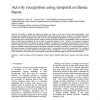182 search results - page 1 / 37 » Activity recognition using temporal evidence theory |
JAISE
2010
13 years 4 days ago
2010
The ability to identify the behavior of people in a home is at the core of Smart Home functionality. Such environments are equipped with sensors that unobtrusively capture informat...
SIGLEX
1991
13 years 8 months ago
1991
This paper argues for a two-level theory of semantics as opposed to a one-level theory, based on the example of the system of temporal and durationM connectives. Instead of identi...
ICDAR
2003
IEEE
13 years 10 months ago
2003
IEEE
The Dempster-Shafer Theory of Evidence is an established method for combining different sources of information. In this paper we explore ways to improve the combination performanc...
EUROSSC
2009
Springer
13 years 8 months ago
2009
Springer
Abstract. In the domain of ubiquitous computing, the ability to identify the occurrence of situations is a core function of being ’contextaware’. Given the uncertain nature of ...
CVPR
2004
IEEE
14 years 7 months ago
2004
IEEE
We present Propagation Networks (P-Nets), a novel approach for representing and recognizing sequential activities that include parallel streams of action. We represent each activi...

